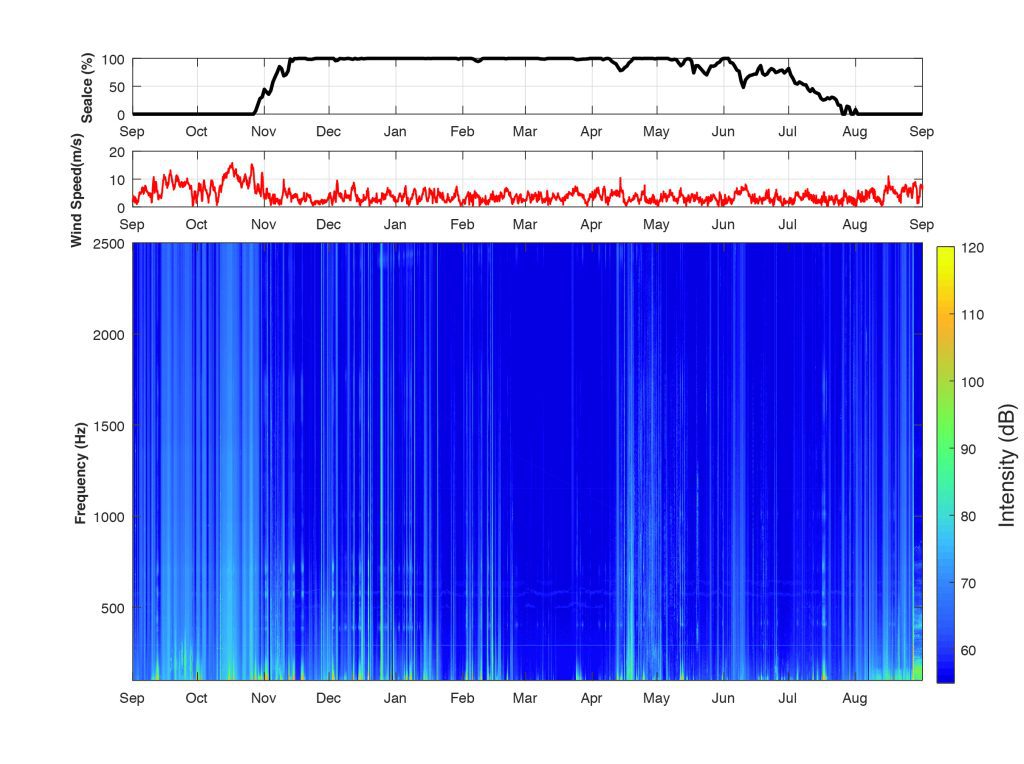K. M. Stafford1
1Applied Physics Laboratory, University of Washington, Seattle, WA, USA
Highlights
- Less sea ice and increasing storminess are making Arctic waters louder during the open water season due to increased wind and wave noise.
- Arctic marine mammals are changing their migratory patterns and subarctic visitors are heard for more of the year and further north as sea ice loss opens habitat for them.
- Arctic shipping traffic between the Pacific and Atlantic Oceans continues to increase and with it, ambient noise levels are increasing in the frequency bands used by marine mammals.
Introduction
In the global ocean, the combination of naturally occurring sounds, including those from wind, waves, underwater earthquakes, and marine animals, make up the underwater ‘soundscape.’ Unique to polar regions is the role sea ice plays in the soundscape, both by generating noise and by dampening noise from the atmosphere. The ice-covered Arctic can experience some of the lowest ambient sound levels in the ocean due to the lack of wind-driven waves in ice-covered regions. Changes in sea ice—reduced thickness, age, extent and changing seasonality—are, however, altering the Arctic underwater acoustic environment in numerous ways. Over the past ~15 years, advances in both long-term deployable acoustic instrumentation and the ability to analyze the resulting terabytes of data, have resulted in sound recordings that provide up to multi-year soundscapes from the Pacific and Atlantic Arctic, north of the Arctic Circle. These data now allow us to understand how loud the oceans are and provide evidence of changes in the geophony (natural sounds of the earth and atmosphere), biophony (sounds produced by living organisms), and anthrophony (human-made sounds). In the Arctic, the main sources of naturally occurring sounds include waves, winds, sea ice, and marine mammals. Sources of human noise include oil and gas exploration and extraction, commercial shipping, research vessels, tugs and barges to supply villages, and local skiffs. However, as seasonal sea ice decreases and the ‘open water season’ lengthens, both natural and anthropogenic influences are changing the underwater soundscape of the Arctic.
Geophony
Wind and breaking waves create sound underwater. In ice-free water there is a direct correlation between increasing wind speeds and increasing ambient sound levels (PAME 2019). And in shallow waters, such as those found in much of the nearshore Arctic, sound levels tend to be higher for the same wind speed than they are in deep waters (PAME 2019). In contrast, the ice-covered Arctic can have some of the lowest ambient sound levels globally due to the lack of wind-driven waves (Han et al. 2021). However, the dynamics of sea ice (Fig. 1a), including ice formation and deformation, pressure ridging, and cracking, can greatly increase ambient sound levels over a broad range of frequencies (PAME 2019). Comparison of wind speed and sea ice cover data in both the Pacific and Atlantic Arctic has shown a clear relationship between wind speed over different sea ice extents with sound levels many times higher under open water than they are under heavy ice (PAME 2019, Fig. 2). Increases in the duration of open water in the Arctic, combined with increased extreme wind events (Zhang et al. 2021) suggest that overall ambient sound levels will continue to increase throughout the Arctic and will remain high as climate change continues to expand open water periods and regions into the future.



Biophony
Throughout the Arctic, marine mammals’ acoustic displays are the dominant contributor to the soundscape. Marine animals, including marine mammals, rely on sound more than other senses to navigate, to find food, for reproductive displays, and to communicate over relatively long distances, and the sounds they produce can be reflective of their behavioral state. For instance, many marine mammals use different signals at different times of the year; in the winter and spring, most Arctic species make reproductive displays that are more elaborate and cover a greater range of frequencies than signals they produce when migrating or feeding (Stafford et al. 2021). In areas that are overwintering hotspots, such as the region to the northwest of St. Lawrence Island, Alaska, the chorus of sounds from multiple species can make it difficult for human listeners to distinguish individual animals or even species (Fig. 1b).
Underwater/under ice monitoring in the Arctic has provided novel information on the seasonal occurrence of Arctic marine mammals over year-long periods (e.g., PAME 2019, and references therein; Ahonen et al. 2019). Much of this information corroborates observations from Indigenous Knowledge holders. In the past few years, acoustic data have been documenting changes in the seasonal distribution of Arctic marine mammals, including during times that humans are not present. In the Pacific Arctic, bowhead whales have been recorded in mid-winter in the Beaufort Sea (Insley et al. 2021; Stafford et al. 2021), far from their wintering grounds in the northern Bering Sea (Huntington et al. 2020). Likewise, acoustic data indicate both bowhead and beluga whales in the Pacific Arctic have delayed migrating out of the Beaufort and Chukchi Seas in the fall (Stafford et al. 2021).
Other biologically driven changes in the soundscape of the Arctic include the detection of subarctic species further north and for longer time periods. This includes decadal-scale changes in the presence of blue and fin whales in Fram Strait (Ahonen et al. 2021); fin whales overwintering in Davis Strait (Simon et al. 2010); and fin, minke, humpback and killer whales (Fig. 1c) moving further north and spending more time in the Chukchi Sea (Hannay et al. 2013; Stafford 2019). While in many instances, these subarctic species provide only short-lived contributions to the overall soundscape, their acoustic detections are clear evidence of a changing Arctic (Moore et al. 2019).
Anthrophony–when ‘sound’ becomes ‘noise’
Globally there has been increasing concern about the impacts of underwater noise on marine animals. In the Arctic, this concern has generally focused on marine mammals. In large part, this is because many species are critical to food security and culture in the Arctic and there are concerns about sound displacing or changing the distribution and accessibility of animals (Huntington et al. 2020). In response to these concerns, numerous national and international organizations have recognized the potential for industrialization of the Arctic to increase underwater noise, and potentially harm endemic species (PAME 2019; Halliday et al. 2020). There is a growing body of literature on how increases in noise affect marine mammals but, especially in a region as relatively inaccessible as the Arctic, understanding the extent of such impacts is difficult. In the Arctic, many anthropogenic sources overlap in frequency with the sounds produced and received by marine mammals. Such signals are more likely to interfere with the animals’ ability to hear and respond to sounds important to them. Low-frequency sounds are more likely to be problematic for bowhead whales, mid-frequencies for ice seals and walrus, and high frequencies for narwhal and belugas (PAME 2019; Halliday et al. 2020).
Sources of man-made sounds in the Arctic include seismic exploration using air guns (which produce loud, low-frequency pulses by releasing pressurized air) for oil and gas and seafloor mapping (Fig. 1d, resource extraction (drilling)) and ships (Fig. 1e), including small boats and larger tourism, research, and commercial vessels. Most of these man-made sources of noise are relatively low frequency. Low frequency sounds, such as those produced by ships and airguns, can carry for hundreds to thousands of kilometers (PAME 2019; Halliday et al. 2020).
The most persistent, and a growing source of anthrophony in the Arctic is cargo and fishing vessels, most of which sail the Northern Sea Route (NSR) across the top of the Russian Federation from the Pacific to the Atlantic (Fig. 3). Fewer vessels use the Northwest Passage, through the Canadian Arctic Archipelago, but that route, too, has seen increased ship traffic with 44% more vessels from 2013 to 2019 (PAME 2021). Most large ships travel through the Arctic during the open water season, but in January 2021, at least four liquid natural gas tankers sailed the NSR without icebreaker support (Northern Sea Route Information Office 2021). Because extensive commercial shipping in the Arctic is a relatively new phenomenon, Arctic species may have a lower tolerance of, and react more strongly to, such noise (PAME 2019). Studies of marine mammals in other oceans have shown that the ranges over which animals communicate is greatly reduced and stress levels increase when large ships pass by (Würsig and Koski 2021). And, as with wind noise discussed above, increases in overall noise levels decrease the range over which Arctic marine mammals can communicate and may have long-term impacts on their ability to navigate, communicate, and reproduce (Halliday et al. 2020, Fig. 4).




Acknowledgments
Funding was provided to K. M. Stafford from the Office of Naval Research Marine Mammals and Biology Program N000142012413.
References
Ahonen, H., K. M. Stafford, C. Lydersen, C. L. Berchok, S. E. Moore, and K. M. Kovacs, 2021: Interannual variability in acoustic detection of blue and fin whale calls in the Northeast Atlantic High Arctic between 2008 and 2018. Endanger. Species Res., 45, 209-224, https://doi.org/10.3354/esr01132.
Ahonen, H., K. M. Stafford, C. Lydersen, L. de Steur, and K. M. Kovacs, 2019: A multi-year study of narwhal occurrence in the western Fram Strait—detected via passive acoustic monitoring. Polar Res., 38, 181, https://doi.org/10.33265/polar.v38.3468.
Halliday, W. D., M. K. Pine, and S. J. Insley, 2020: Underwater noise and Arctic marine mammals: review and policy recommendations. Environ. Rev., 28, 438-448, https://doi.org/10.1139/er-2019-0033.
Han, D. -G., and Coauthors, 2021: Effects of geophony and anthrophony on the underwater acoustic environment in the East Siberian Sea, Arctic Ocean. Geophys. Res. Lett., 48, e2021GL093097, https://doi.org/10.1029/2021GL093097.
Hannay, D. E., J. Delarue, X. Mouy, B. S. Martin, D. Leary, J. N. Oswald, and J. Vallarta, 2013: Marine mammal acoustic detections in the northeastern Chukchi Sea, September 2007-July 2011. Cont. Shelf Res., 67, 127–146, https://doi.org/10.1016/j.csr.2013.07.009.
Huntington, H. P., and Coauthors, 2020: Evidence suggests potential transformation of the Pacific Arctic ecosystem is underway. Nat. Climate Change, 10, 342–348, https://doi.org/10.1038/s41558-020-0695-2.
Insley, S. J., W. D. Halliday, X. Mouy, and N. Diogou, 2021: Bowhead whales overwinter in the Amundsen Gulf and Eastern Beaufort Sea. Roy. Soc. Open Sci., 8, 202268, https://doi.org/10.1098/rsos.202268.
Moore, S. E., T. Haug, G. A. Vikingsson, and G. B. Stenson, 2019: Baleen whale ecology in arctic and subarctic seas in an era of rapid habitat alteration. Prog. Oceanogr., 176, 102118, https://doi.org/10.1016/j.pocean.2019.05.010.
Northern Sea Route Information Office, 2021. NSR shipping traffic. Accessed 15 September 2021, https://arctic-lio.com/nsr-shipping-traffic-activities-in-january-april-2021/.
PAME, 2019: Underwater Noise in the Arctic: A State of Knowledge Report, Roveniemi, May 2019.
PAME, 2021: Shipping in the Northwest Passage: comparing 2013 with 2019, Roveniemi, May 2019.
Simon, M., K. M. Stafford, K. Beedholm, C. M. Lee, and P. T. Madsen, 2010: Singing behavior of fin whales in the Davis Strait with implications for mating, migration and foraging. J. Acoust. Soc. Amer., 128, 3200-3210, https://doi.org/10.1121/1.3495946.
Stafford, K. M., 2019: Increasing detections of killer whales (Orcinus orca), in the Pacific Arctic. Mar. Mammal Sci., 35(2), 696-706, https://doi.org/10.1111/mms.12551.
Stafford, K. M., J. J. Citta, S. Okkonen, and J. Zhang, 2021: Bowhead and beluga whale acoustic detections in the western Beaufort Sea 2008-2018. PLoS ONE, 16, e0253929, https://doi.org/10.1371/journal.pone.0253929.
Würsig, B., and W. R. Koski, 2021: Naturally and potentially disturbed behavior of bowhead whales. The Bowhead Whale, J. G. M. Thewissen JGM and J. C. George, Eds. Elsevier Publishing; ISBN: 978-0-12-818969-6.
Zhang, F., X. Pang, R. Lei, M. Zhai, X. Zhao, and C. Q, 2021: Arctic sea ice motion change and response to atmospheric forcing between 1979 and 2019. Int. J. Climatol., 1-23, https://doi.org/10.1002/joc.7340.
November 9, 2021
